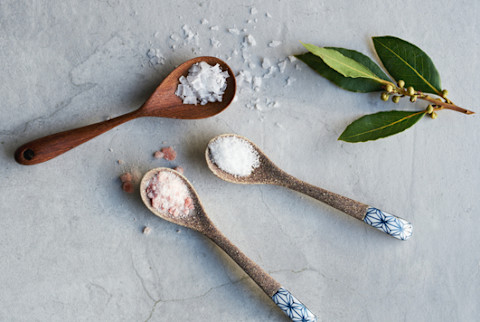Your Fancy Himalayan Salt Is Putting Your Thyroid At Risk. Here's Why (And What To Do About It)

Iodine is an essential trace mineral that your body needs in order to make thyroid hormones. Triiodothyronine (or T3) is the active thyroid hormone in your body and it contains three iodine molecules. When we are iodine deficient we are at greater risk of goiter and hypothyroidism (or low thyroid function). Iodized table salt has been fortified with iodine, so, as I explain in my book, The Salt Fix, the low-salt advice may be contributing to iodine deficiency and inadvertently harming your thyroid.
Why your salt is putting your health at risk.

However, health buffs making an effort to consume more natural sea salts such as Hawaiian, Celtic, and even precious Himalayan pink salt may also be putting their thyroids at risk. The reason? These sea salts lack stable amounts of iodine. Celtic sea salt and Hawaiian sea salts have little to no iodine and while some batches of Himalayan salt may have good amounts of iodine, others seem to have very little. Consuming these fancy sea salts is basically an expensive gamble when it comes to obtaining sufficient amounts of iodine.
Over 2 billion people worldwide are at risk of iodine deficiency1, with 30 countries still being classified as iodine-deficient2. Salt restriction is in direct conflict with programs trying to prevent iodine deficiency through salt fortification. And considering that some people may lose more than 50 mcg of iodine per hour of exercise, you should practice even more caution around salt restriction and consuming non-iodized salts if you’re a regular at the gym. In fact, if you fall into this category you may even need to supplement with iodine, especially if your diet isn’t rich in this mineral (iodine is found in good amounts in cranberries, dairy, and seaweed).
Proceed with even more caution if you’re pregnant or planning to become pregnant. The World Health Organization (WHO) recommends consuming less than 5 grams of salt each day to reduce the risk of high blood pressure. However, if dietary iodine intake is poor, around 5 grams of iodized salt is needed to reach the recommended amount of iodine in pregnant women. And even more than 5 grams of iodized salt would be needed for lactating mothers. Do you see the problem here?
Anyone can be iodine-deficient.

It should not be assumed that pregnant or lactating women will consume adequate amounts of iodine in the diet or in supplements. Considering that iodine requirements increase by more than 50 percent during pregnancy3, and that the negative health consequences of iodine deficiency in pregnancy can be impaired neurological development in the fetus, there should be greater caution with salt restriction in women who are pregnant or plan on becoming pregnant. Weaning infants4 are also at particularly high risk of iodine deficiency and our fear of salting our children’s food isn’t helping matters either.
Thyroid cancer is the most common endocrine cancer in most countries and the incidence of thyroid cancer is increasing5. A comprehensive review of animal and human studies found that iodine deficiency is a risk factor for thyroid cancer5 with higher intakes of iodine being associated with a lower risk of thyroid cancer. In those with iodine deficiency, eating more iodized salt may shift thyroid cancer subtypes toward less malignant forms6. Considering that low-salt diets can increase the risk of iodine deficiency7, they may also be increasing the risk of hypothyroidism and thyroid cancer. Talk about a double-whammy on your thyroid.
Population-wide salt restriction may be increasing the risk of mental impairments8 in our children. At least 50 million people9 worldwide may be affected by iodine deficiency-related brain damage. Iodine takes care of our children, so we should take care by not blindly following population-wide salt restriction. Learn about my No. 1 recommended salt in my book The Salt Fix. Not only does this salt have good amounts of iodine, but it also has good amounts of many other nutrients lacking in regular table salt.
What to do now.

We have a lot to be thankful for when it comes to salt. In fact, we can thank seawater10 for the discovery of iodine. And we may someday thank salt again but this time for helping to prevent thyroid dysfunction, thyroid cancer, and mental impairments in our children. Until then, if you are not eating a diet containing good amounts of iodine (such as cranberries, dairy, or eggs) you may want to reconsider salt restriction. Instead, a better idea may be to reach for the salt, either a salt that naturally contains iodine (such as certain sea salts) or the good old-fashioned iodized salt.
The Salt Fix by Dr. James DiNicolantonio is available for purchase here.
10 Sources
- https://www.ncbi.nlm.nih.gov/pubmed/?term=Endocr+Rev.+2009+Jun%3B30(4)%3A376-408.+doi%3A+10.1210%2Fer.2009-0011.+Epub+2009+May+21.Iodine+deficiency
- https://www.ncbi.nlm.nih.gov/pubmed/?term=Global+iodine+nutrition%3A+Where+do+we+stand+in+2013%3F
- https://www.ncbi.nlm.nih.gov/pubmed/22742605
- https://www.ncbi.nlm.nih.gov/pubmed/?term=Are+weaning+infants+at+risk+of+iodine+deficiency+even+in+countries+with+established+iodized+salt+programs%3F
- https://www.ncbi.nlm.nih.gov/pubmed/?term=Thyroid+Res.+2015+Jun+18%3B8%3A8.+doi%3A+10.1186%2Fs13044-015-0020-8.+eCollection+2015.Iodine+intake+as+a+risk+factor+for+thyroid+cancer%3A+a+comprehensive+review+of+animal+and+human+studies
- https://www.ncbi.nlm.nih.gov/pubmed/25591468
- https://www.ncbi.nlm.nih.gov/pubmed/25908676
- https://www.ncbi.nlm.nih.gov/pubmed/?term=Lancet.+2008+Oct+4%3B372(9645)%3A1251-62.+doi%3A+10.1016%2FS0140-6736(08)61005-3.Iodine-deficiency+disorders
- https://www.ncbi.nlm.nih.gov/pmc/articles/PMC3637997/
- https://www.ncbi.nlm.nih.gov/pubmed/?term=J+Nutr.+2008+Nov%3B138(11)%3A2060-3.Research+on+iodine+deficiency+and+goiter+in+the+19th+and+early+20th+centuries
